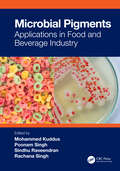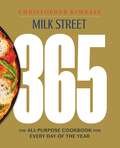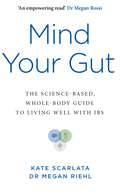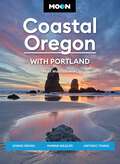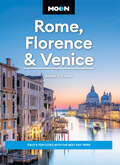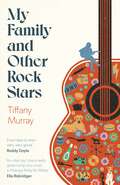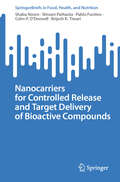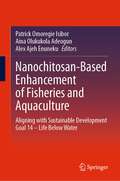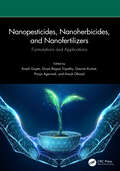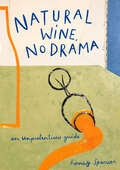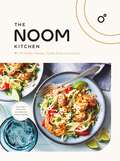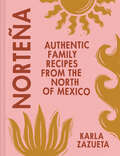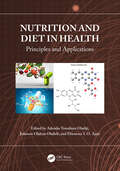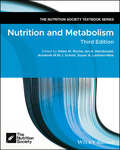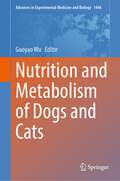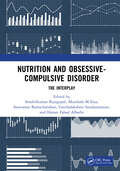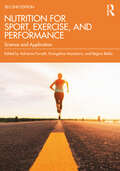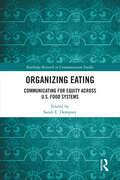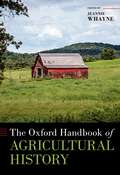- Table View
- List View
Microbial Pigments: Applications in Food and Beverage Industry
by Mohammed Kuddus Poonam Singh Raveendran Sindhu Rachana SinghMicrobial Pigments: Applications in Food and Beverage Industry offers a comprehensive and updated review of the impact of microbial pigments as value-added products in the food and beverage industry. Microbes produce a range of valuable pigments such as carotenoids, flavins, melanins, quinines, and violacein. The book explores the use of microbial pigments as additives, antioxidants, color intensifiers, and functional food ingredients. It discusses pigment isolation and processing technologies. It covers a range of applications across products like jams, spreads, frozen desserts, and beverages. The book also discusses food safety and toxicology aspects. Key features Explores the various microbial pigments and their sources Reviews the pigment isolation, production, and processing techniques Discusses the potential application of pigments across a range of products in the food and beverage industry Includes the latest innovations and patents awarded in use of microbial pigments as value-added food products The book is meant for researchers, academic and industry experts in food biotechnology, food processing, and food microbiology.
Milk Street 365: The All-Purpose Cookbook for Every Day of the Year
by Christopher KimballCook with confidence every day! Dig into 365 essential recipes and tons of foundational resources—from the James Beard Award winning team at Christopher Kimball&’s Milk Street. This is Milk Street&’s new and comprehensive guide to today&’s recipe repertoire, full of fresh flavors and simple yet game-changing techniques. This is everyday cooking you actually want to cook every day. Milk Street 365 is both inspiration and reference for the contemporary kitchen, with recipes that will change the way you cook at home==from soups, stews and salads to flatbreads, pizzas and noodles. Dishes include: Velvety Turkish Scrambled Eggs with Yogurt Vietnamese Pork and Scallion Omelette Butter Beans in Tomato Sauce with Dill and Feta Thai Green Curry Chicken and Vegetables Taiwanese Five-Spice Pork with Rice Garlic-Rosemary Burgers with Taleggio Sauce Cheese-Crisped Pinto Bean Quesadillas Plus deep dives into ingredients, pantry basics, and foundational techniques that every cook should master. You&’ll learn better ways to roast chicken (hint: flat birds crisp better, and seasonings stay in place when slid under the skin) and discover bold finishes for chops and steaks (think a slather of cilantro-lime sauce or a smear of miso butter). Here, fundamental recipes and their nearly endless variations are paired with lessons on the art and science of good cooking. Sidebars and charts deliver valuable guidance about the tools, ingredients and techniques that comprise the modern kitchen. It&’s a 360-degree approach for all 365 days of the year.
Mind Your Gut: The Science-based, Whole-body Guide to Living Well with IBS
by Kate Scarlata Dr Megan RiehlHow to understand your symptoms and live well with IBS.IBS impacts millions of people around the world – it is tricky to diagnose and miserable to live with. Through a comprehensive, holistic approach to living with IBS, Mind Your Gut reveals:- How to understand the mind-gut connection- The impact of stress on your gut- Easy to implement, symptom-specific solutions for your IBS- Nutritious recipes to calm your belly and maximise your gut health- How to make healthy food choices in a food-fear and weight-obsessed culture- When to re-examine your symptoms with your doctor and how to identify IBS mimickers, and much more.Packed with science-based interventions, targeted mind-gut behavioural strategies and delicious, gut-soothing recipes, Mind Your Gut offers a full toolbox of therapeutic options to help manage your IBS.
Moon Coastal Oregon: Scenic Drives, Marine Wildlife, Historic Towns (Travel Guide)
by Matt Wastradowski Moon Travel GuidesFrom stunning coastline to charming towns to wildlife watching, find your adventure with Moon Coastal Oregon. Inside you'll find:Flexible itineraries, including a weeklong road trip to experience the best of the Oregon Coast The top outdoor adventures: Go tidepooling, watch for migrating whales, and see hundreds of sea lions. Hike along epic coastal dunes, take a surfing lesson, and catch a sunset at iconic Haystack Rock. Join a fishing charter, camp beside the ocean, or take a jet boat tour to spot wildlife on the Rogue River. Can't-miss experiences and unique activities: Feast on fresh seafood in quaint seaside towns, check out Astoria's craft beer scene, or try tasty treats at the famous Tillamook cheese factory. Climb to the top of historic lighthouses, explore a shipwreck, and learn about local maritime history. Expert insight from Oregon local Matt Wastradowski on when to go, how to get around, and where to stay Full-color photos and detailed maps throughoutThorough background information on the culture, landscape, climate, and wildlife, plus handy recommendations for international visitors, families with kids, travelers of color, women travelers, and more With Moon's expert tips and local know-how, you can experience the best of Coastal Oregon. Exploring more of the state? Try Moon Oregon or Moon Columbia River Gorge & Mount Hood. Looking for outdoor adventure? Check out Moon Oregon Hiking.About Moon Travel Guides: Moon was founded in 1973 to empower independent, active, and conscious travel. We prioritize local businesses, outdoor recreation, and traveling strategically and sustainably. Moon Travel Guides are written by local, expert authors with great stories to tell—and they can't wait to share their favorite places with you. For more inspiration, follow @moonguides on social media.
Moon Rome, Florence & Venice: Italy's Top Cities with the Best Day Trips (Travel Guide)
by Alexei J. Cohen Moon Travel GuidesExperience world-famous art, stroll romantic streets, and savor the flavors of Italy's top cities. Inside Moon Rome, Florence & Venice you'll find:Flexible itineraries for three to four days in Rome, Florence, and Venice that can be combined into a longer trip Must-see highlights and unique experiences: Cycle the Borghese park on a sunny day, learn classic Italian recipes in a cooking class, and admire masterworks by Bernini, Botticelli, and Caravaggio. Hike to sprawling hilltop views of Florence, meander through historic museums, or catch the Gregorian chants being sung at the Duomo on a Sunday morning. Stroll through Venice's fish markets, rent a kayak and explore the winding canals, and bask in the afternoon sun as you sip a Negroni on a piazza The best local flavors: From pizza al taglio, fritto misto, and mouthwatering pastas to seasonal vegetables and fresh seafood delicacies, get to know each city's unique culinary scene Ideas for side trips, including Assisi, Chianti, Siena, and Bologna Expert insight from American-turned-Roman Alexei Cohen on his adopted home country Full-color photos and detailed maps throughoutBackground information on the landscape, history, and cultural customs of each city Handy tools such as visa information, an Italian phrasebook, and tips for families, travelers with disabilities, women travelers, travelers of color, LGBTQ+ travelers, and senior travelers Experience la dolce vita at your own pace with Moon Rome, Florence & Venice. Exploring more of Italy? Try Moon Southern Italy or Moon Sicily.About Moon Travel Guides: Moon was founded in 1973 to empower independent, active, and conscious travel. We prioritize local businesses, outdoor recreation, and traveling strategically and sustainably. Moon Travel Guides are written by local, expert authors with great stories to tell—and they can't wait to share their favorite places with you. For more inspiration, follow @moonguides on social media.
My Family and Other Rock Stars: 'A love letter to a remarkable childhood' Sarah Winman
by Tiffany Murray'From start to end - very, very good' RODDY DOYLE 'Full of pop gossip that'll leave you starry-eyed, and written with a warmth and precision you'll want to savour for as long as you can . . . I didn't want it to end' SÉAMAS O'REILLY 'Funny, vivid and touching . . . An utter treat' RACHEL JOYCE____________________________________________________________________________In a small corner of a field in Wales, Tiffany Murray is hiding with Boggle the dog, dreaming of her mum's moussaka, blackberry and apple crumble, and, if she's lucky, ice-cold lemonade. A sheep bleats. The smell of hay tickles her nose. The twang of a guitar and crack of a snare carry on the breeze.It's the late 1970s and Tiff lives with her mum, Joan, at Rockfield, the iconic recording studios. This place of legend, where some of the most famous rock albums of all time were recorded, is the background to a freewheeling, ever-changing whirlwind of a childhood. Tiff's days are spent running around the farm, making friends with local wildlife and helping out with the endless array of dishes her mum creates to keep the bands fed. She's looking for a dog, she's looking for a father; but the one constant throughout is her and Joan, building an unconventional family in the most unlikely of locations.My Family and Other Rock Stars is Tiff's remarkable, truly unique story of growing up in a rural idyll, of Cordon Bleu cookery and of a childhood where the chances of bumping into Freddie Mercury playing piano, or a group of Hell's Angels turning up to record for Lemmy, or even the hope of David Bowie appearing, were as normal as hopscotch and homework.
Nanocarriers for Controlled Release and Target Delivery of Bioactive Compounds (SpringerBriefs in Food, Health, and Nutrition)
by Shaba Noore Shivani Pathania Pablo Fuciños Colm P. O'Donnell Brijesh K. TiwariThis brief provides a comprehensive overview of nanocarriers used for nanoencapsulation of bioactive compounds. It includes the basis of encapsulation mechanism, encapsulation efficiency, controlled release, target delivery, and its application in food, nutraceuticals, pharmaceuticals and cosmeceuticals.
Nanochitosan-Based Enhancement of Fisheries and Aquaculture: Aligning with Sustainable Development Goal 14 – Life Below Water
by Patrick Omoregie Isibor Aina Olukukola Adeogun Alex Ajeh EnunekuNanochitosan-Based Enhancement of Fisheries and Aquaculture: Aligning with Sustainable Development Goal 14 – Life Below Water is an indispensable guide for envisioning an ecologically balanced and prosperous future for aquatic resource management. The book explores the innovative application of nanochitosan in aquatic resource management, delineating the cutting-edge potentials of the novel biopolymer to reshape the landscape of fisheries and aquaculture and align with the ambitions of the United Nations Sustainable Development Goals (Goal 14: Life Below Water). The book focuses on sustainability and showcases nanochitosan's capacity to elevate water quality, bolster aquatic well-being, and revolutionize aquaculture disease control, breeding, detoxification, and feed quality. Through practical applications, interdisciplinary insights, and a strong emphasis on food safety and conservation, readers gain a multifaceted understanding of thefield's advancements, future potential, challenges, and requisite nanochitosan-based techniques. This work navigates complex scientific concepts clearly, catering to a diverse audience, including researchers, practitioners, and students.
Nanopesticides, Nanoherbicides, and Nanofertilizers: Formulations and Applications
by Anjali Gupta Divya Bajpai Tripathy Gaurav Kumar Pooja Agarwal Anujit GhosalNanopesticides, Nanoherbicides, and Nanofertilizers: Formulations and Applications demonstrates the potential for nanomaterials to revolutionize modern agriculture to become more sustainable. A team of expert scientists explain how the nanoformulation of traditionally used herbicides, fertilizers, and pesticides can protect large-scale crops from unwanted weeds and pests as well as from the environmental side effects that are caused by the bulk application of chemicals. This book demonstrates how nanomaterials, such as hydroxyapatite, clay minerals, zeolites, and polyacrylic acid, have been successfully used to develop fertilizers that promote a slower release of chemicals due to the unique properties of nanomaterials. Their use in lower concentrations helps in decreasing the toxicity to non-targeted organisms as well as lowering the risk of environmental degradation. FEATURES: • Categorically discusses the formulations and applications of nanopestides, nanoherbicides, and nanofertilizers, as well as their impact on the environment. • Presents chapters on patent landscape, environmental acceptability, and environmental risks. • Addresses degradation of nanoparticles as well expected toxicity and drawbacks of nanomaterial-based pesticides, herbicides, and fertilizers. This book is essential reading for researchers and professionals working in the fields of biotechnology, nanomaterials and agricultural chemistry. Dr. Anjali Gupta is Professor and Researcher in the Division of Chemistry, Galgotias University, Uttar Pradesh, India. Dr. Divya Bajpai Tripathy is Professor and Researcher in the Division of Forensic Science, Galgotias University, Uttar Pradesh, India. Dr. Gaurav Kumar is Associate Professor in Clinical Research Division and Institution's Innovation Council In-Charge at Galgotias University, Uttar Pradesh, India. Dr. Pooja Agarwal is Professor in the Division of Chemistry, Galgotias University, Uttar Pradesh, India. Dr. Anujit Ghosal is Researcher at the Richardson Centre for Food Technology and Research, Department of Food and Human Nutritional Sciences, The University of Manitoba, Canada.
Nanopesticides, Nanoherbicides, and Nanofertilizers: Formulations and Applications
by Anjali Gupta Divya Bajpai Tripathy Gaurav Kumar Pooja Agarwal Anujit GhosalNanopesticides, Nanoherbicides, and Nanofertilizers: Formulations and Applications demonstrates the potential for nanomaterials to revolutionize modern agriculture to become more sustainable. A team of expert scientists explain how the nanoformulation of traditionally used herbicides, fertilizers, and pesticides can protect large-scale crops from unwanted weeds and pests as well as from the environmental side effects that are caused by the bulk application of chemicals. This book demonstrates how nanomaterials, such as hydroxyapatite, clay minerals, zeolites, and polyacrylic acid, have been successfully used to develop fertilizers that promote a slower release of chemicals due to the unique properties of nanomaterials. Their use in lower concentrations helps in decreasing the toxicity to non-targeted organisms as well as lowering the risk of environmental degradation. FEATURES: • Categorically discusses the formulations and applications of nanopestides, nanoherbicides, and nanofertilizers, as well as their impact on the environment. • Presents chapters on patent landscape, environmental acceptability, and environmental risks. • Addresses degradation of nanoparticles as well expected toxicity and drawbacks of nanomaterial-based pesticides, herbicides, and fertilizers. This book is essential reading for researchers and professionals working in the fields of biotechnology, nanomaterials and agricultural chemistry. Dr. Anjali Gupta is Professor and Researcher in the Division of Chemistry, Galgotias University, Uttar Pradesh, India. Dr. Divya Bajpai Tripathy is Professor and Researcher in the Division of Forensic Science, Galgotias University, Uttar Pradesh, India. Dr. Gaurav Kumar is Associate Professor in Clinical Research Division and Institution's Innovation Council In-Charge at Galgotias University, Uttar Pradesh, India. Dr. Pooja Agarwal is Professor in the Division of Chemistry, Galgotias University, Uttar Pradesh, India. Dr. Anujit Ghosal is Researcher at the Richardson Centre for Food Technology and Research, Department of Food and Human Nutritional Sciences, The University of Manitoba, Canada.
Natural Wine, No Drama: An Unpretentious Guide
by Honey SpencerDiscover the world of natural wine… without all the drama. Honey Spencer is determined to help everyone understand and enjoy all that each unique glass has to offer.
The Noom Kitchen: 100 Healthy, Delicious, Flexible Recipes for Every Day
by Noom Inc.The only official Noom cookbook! Easy, healthy, nutritious recipes for achieving your health goals deliciously!Noom is a global phenomenon-their digital health and weight management program has helped millions lose weight and feel better by focusing on the psychology of food and behavior change. The Noom Kitchen - follow-up to Noom's bestselling book The Noom Mindset -offers spectacularly delicious recipes that make serving health-forward foods easy for cooks of all skill levels. The majority of the recipes focus on using 'green foods', nutritionally dense ingredients that fill you up without weighing you down. With selections like Saucy Pizza-Stuffed Chicken Breast, Spinach & Feta 'Hot Pockets,' and Easy Strawberry Cheesecake Ice Cream, The Noom Kitchen applies Noom's trademark approach to nutrition to help readers:- Put a healthy twist on favorite foods like french fries, pizza, and dessert- Cook meals and snacks designed to be portable and storable so you can eat well on-the-go- Learn new techniques for boosting the nutrient density (and decreasing the caloric density) of any meal.These recipes will appeal to dedicated Noom users and new readers alike, providing accessible culinary guidance for anyone looking to kick-start their health and wellness in the kitchen.
Norteña: Authentic Family Recipes from Northern Mexico
by null Karla ZazuetaPassed down through the generations of Karla Zazueta’s family, she explores cooking techniques and ingredients brought in from lesser explored regions. This is a true taste of northern Mexico using fresh produce, bursting with flavour, colour and – crucially – history. The Mexican cuisine that most people are familiar with is from the centre or the south of the country, but in Norteña, Karla Zazueta shares the dishes and ways of cooking that she grew up with. Norteña – meaning ‘northerner’ – tells the tale of the northern states of Mexico – of the coastlines and fresh seafood, the cattle ranches, sun-ripened fruit and vegetables and the family gatherings around the table. The recipes in the book include the world-famous Baja fish tacos, ‘piggy’ pinto beans, vegan chorizo, crab tostadas, sopes (corn patties) served in a tomato broth and empanadas californianas (shredded beef empanadas), all accompanied by mouth-watering spicy salsas, fresh queso and zingy salads. There are recipes para la sed (for the thirst), which includes the best margaritas. The book ends on something sweet, with recipes such as Mexican flan and camotes (sweet potato poached until tender in a sweet, spiced syrup). The recipes are accompanied by longer texts that describe the different cultural events and influences that play such a huge part in the cuisine, such as the tamales estilo Sinaloa, wrapped with special care at Christmas time. Karla’s understanding of flavour shines through in her recipes and she suggests substitutes throughout so you can recreate the authentic taste using ingredients from the supermarket. In addition, many of the meat and fish dishes are given a vegetarian alternative so that you can adapt the recipes for everyone to enjoy. By sharing her family recipes, taking influence from her travels and tastes, Karla makes sure that each dish is packed with flavour but also cooked with love. Let yourself be transported to the Baja peninsula, rolling corn tortillas in the sun, sipping on a refreshing michelada and cooled by the breeze coming in from the sea. Contents Buenos Dias/Good Morning Esenciales Norteñas/Northern Essentials Algo Picosito/Something Spicy Del Huerto/From the Garden Del Mar/From the Sea Del Rancho/From the Ranch Final Dulce/Sweet Ending Para la Sed/For the Thirst Carne Asada/Mexican Feast
Nutrition and Diet in Health: Principles and Applications
by Adenike Temidayo Oladiji Johnson Olaleye Oladele Ebenezer I. O. AjayiNutrition and diet play a crucial role in sustaining good health throughout human lives. Food provides us with essential nutrients involved in many physiological activities and biological processes in the body including growth and development, metabolism, immune function, and overall well-being. Nutrition and Diet in Health: Principles and Applications reviews and discusses the issues related to the roles of nutrition and diet in human health and diseases.The book contains two sections – one section features principles, the other, covers applications. Part I provides information on sustainable use of nutrition and diets in health and diseases; advanced biotechnological approaches to improve nutritional content of food; trace elements in nutrition; drug and nutrient interactions; functional foods and nutraceuticals in health maintenance; and biomarkers of functional foods and nutraceuticals in health maintenance. Part II discusses the significance of nutrition in selected human diseases, including cardiovascular diseases, cancer, infection, neurodegenerative diseases, and metabolic co-morbidities. It also discusses optimal nutrition for wellness, fitness, pregnancy, mental health, aging, and longevity.Features Molecular and cellular-based research findings on the principles and applications of nutrition and diet in health Roles of nutritional agents in the pathogenesis of human diseases Underlying mechanisms that govern activities and strategies to prevent pathological conditions using nutritional agents Nutrition and Diet in Health: Principles and Applications is suitable for academia and scientists, enhances knowledge of students in healthcare and areas of biological sciences.
Nutrition and Diet in Health: Principles and Applications
Nutrition and diet play a crucial role in sustaining good health throughout human lives. Food provides us with essential nutrients involved in many physiological activities and biological processes in the body including growth and development, metabolism, immune function, and overall well-being. Nutrition and Diet in Health: Principles and Applications reviews and discusses the issues related to the roles of nutrition and diet in human health and diseases.The book contains two sections – one section features principles, the other, covers applications. Part I provides information on sustainable use of nutrition and diets in health and diseases; advanced biotechnological approaches to improve nutritional content of food; trace elements in nutrition; drug and nutrient interactions; functional foods and nutraceuticals in health maintenance; and biomarkers of functional foods and nutraceuticals in health maintenance. Part II discusses the significance of nutrition in selected human diseases, including cardiovascular diseases, cancer, infection, neurodegenerative diseases, and metabolic co-morbidities. It also discusses optimal nutrition for wellness, fitness, pregnancy, mental health, aging, and longevity.Features Molecular and cellular-based research findings on the principles and applications of nutrition and diet in health Roles of nutritional agents in the pathogenesis of human diseases Underlying mechanisms that govern activities and strategies to prevent pathological conditions using nutritional agents Nutrition and Diet in Health: Principles and Applications is suitable for academia and scientists, enhances knowledge of students in healthcare and areas of biological sciences.
Nutrition and Metabolism (The Nutrition Society Textbook)
by Helen M. Roche Ian A. Macdonald Annemie M. W. J. Schols Susan A. Lanham-NewComprehensive resource on all aspects of nutrition and metabolism; covering vitamin and mineral deficiencies, diseases, immunity, brain and bone health, and more. Now in its third edition, Nutrition and Metabolism has been updated throughout to present readers with the core principles of nutrition in the context of a systems and health approach. Written by a team of internationally renowned experts, the text includes information on: Body composition, energy metabolism, proteins, amino acids, carbohydrates, lipids, vitamins, minerals, trace elements, food intake, and food composition Energy, macronutrients, pregnancy and lactation, growth and aging, brain nutrition, sensory systems and food palatability, the gastrointestinal system, and the cardiovascular system Societal food choices, over- and undernutrition, eating disorders, dieting, foetal programming, cancer, osteoporosis, and diabetes How nutrition affects the liver, pancreas, kidney, lungs, heart and blood vessels, and how nutrition relates to the development of traumatic, infectious, and malignant diseases Nutrition and Metabolism is an essential resource for students and practitioners of nutrition and dietetics, as well as students majoring in other subjects that have a nutrition component.
Nutrition and Metabolism (The Nutrition Society Textbook)
by Helen M. Roche Ian A. Macdonald Annemie M.W.J. Schols Susan A. Lanham-NewComprehensive resource on all aspects of nutrition and metabolism; covering vitamin and mineral deficiencies, diseases, immunity, brain and bone health, and more. Now in its third edition, Nutrition and Metabolism has been updated throughout to present readers with the core principles of nutrition in the context of a systems and health approach. Written by a team of internationally renowned experts, the text includes information on: Body composition, energy metabolism, proteins, amino acids, carbohydrates, lipids, vitamins, minerals, trace elements, food intake, and food composition Energy, macronutrients, pregnancy and lactation, growth and aging, brain nutrition, sensory systems and food palatability, the gastrointestinal system, and the cardiovascular system Societal food choices, over- and undernutrition, eating disorders, dieting, foetal programming, cancer, osteoporosis, and diabetes How nutrition affects the liver, pancreas, kidney, lungs, heart and blood vessels, and how nutrition relates to the development of traumatic, infectious, and malignant diseases Nutrition and Metabolism is an essential resource for students and practitioners of nutrition and dietetics, as well as students majoring in other subjects that have a nutrition component.
Nutrition and Metabolism of Dogs and Cats (Advances in Experimental Medicine and Biology #1446)
by Guoyao WuThis book provides new knowledge about the nutrition and metabolism, as well as the roles of nutrients in the immunity, health, and management of companion animals (dogs and cats). The domestic dog (facultative carnivore) and the domestic cat (obligate carnivore) have evolved differentially in their digestive tract, nutrition, metabolism, chemical sensing, and feeding behavior. These animals have been human companions for at least 12,000 and 9,000 years, respectively, and continue to contribute to the mental health and well-being of children, adolescents, and adults. Both dogs and cats have become increasingly popular in many countries and worldwide over the past decades. Comprehensive update about how the animals utilize dietary nutrients for optimum growth, development, and health is beneficial for their owners, as well as students and researchers. Chapter 4: Characteristics of Nutrition and Metabolism in Dogs and Cats is available open access under a Creative Commons Attribution 4.0 International License
Nutrition and Obsessive-Compulsive Disorder: The Interplay
by Hanan Fahad Alharbi Senthilkumar Rajagopal M. Mohamed Essa Saravanan Ramachandran Geethalakshmi SundararamanThis reference book discusses the role of nutrition in obsessive-compulsive disorders (OCD). It covers the investigational therapies in OCD, use of animal models, and biomarkers for better diagnosis, monitoring, and possible therapeutic options with nutrients for patients with OCD. This book highlights the role of probiotics, amino acids, vitamins, micronutrients, and salts in the management of OCD. It includes such topics as applications of computational modeling and nano-biotechnology in OCD, the effects of environmental pollutants, and the regulation of antidepressants in OCD.KEY FEATURES Covers emerging therapeutic and nutritional approaches for the treatment and management of OCD Reviews the role of various micronutrients in OCD Discusses the prenatal genetic diagnosis and application of computational modelling in OCD Includes the nutritional and dietary roles in such neuropsychiatric disorders as depression and obsessive-compulsive disorder (OCD) Explores the application of nano-biotechnology in OCD This book is meant for researchers and professionals in the field of nutritional neuroscience and psychology
Nutrition and Obsessive-Compulsive Disorder: The Interplay
by Senthilkumar Rajagopal Musthafa M Essa Saravanan Ramachandran Geethalakshmi Sundararaman Hanan Fahad AlharbiThis reference book discusses the role of nutrition in obsessive-compulsive disorders (OCD). It covers the investigational therapies in OCD, use of animal models, and biomarkers for better diagnosis, monitoring, and possible therapeutic options with nutrients for patients with OCD. This book highlights the role of probiotics, amino acids, vitamins, micronutrients, and salts in the management of OCD. It includes such topics as applications of computational modeling and nano-biotechnology in OCD, the effects of environmental pollutants, and the regulation of antidepressants in OCD.KEY FEATURES Covers emerging therapeutic and nutritional approaches for the treatment and management of OCD Reviews the role of various micronutrients in OCD Discusses the prenatal genetic diagnosis and application of computational modelling in OCD Includes the nutritional and dietary roles in such neuropsychiatric disorders as depression and obsessive-compulsive disorder (OCD) Explores the application of nano-biotechnology in OCD This book is meant for researchers and professionals in the field of nutritional neuroscience and psychology
Nutrition for Sport, Exercise, and Performance: Science and Application
by Adrienne Forsyth Evangeline Mantzioris Regina BelskiNutrition for Sport, Exercise, and Performance offers a clear, practical, and accessible guide to building a comprehensive understanding of sport and exercise nutrition from leading experts in nutrition and exercise science. Nutrition before, during, and after training or a sporting event can improve the comfort, energy, and performance of athletes of all levels, from elite to recreational, as well as providing long-term health benefits. As such, nutrition is a key element of an athlete’s health and performance strategy, whether competing recreationally or at an elite level.Split into three parts, this new and revised edition of Nutrition for Sport, Exercise, and Performance provides an evidence-based introduction to nutrition for sport, exercise, and performance. Part I focusses on nutrition and sport science by explaining key principles underpinning sports nutrition science, including energy systems, exercise physiology and metabolism, and the digestion and absorption of macronutrients and micronutrients essential for performance and discusses factors influencing dietary intake, energy availability, and the process of dietary assessment. Part II is focussed on nutrition for exercise, pre- and post-training, hydration, supplements, and body composition measurement and modification. The final part (Part III) focusses on applied sports nutrition for a range of sports and athletes. This second edition delivers new insights into working with female athletes, occupational athletes, and athletes in contemporary sports including sport climbing, surfing, skateboarding, and breaking.Featuring contributions from a range of sport and exercise nutrition professionals with practical sports nutrition strategies and the latest evidence and practice guidelines, this is a core reference for undergraduate students, sports professionals, and aspiring athletes alike.
Nutrition for Sport, Exercise, and Performance: Science and Application
Nutrition for Sport, Exercise, and Performance offers a clear, practical, and accessible guide to building a comprehensive understanding of sport and exercise nutrition from leading experts in nutrition and exercise science. Nutrition before, during, and after training or a sporting event can improve the comfort, energy, and performance of athletes of all levels, from elite to recreational, as well as providing long-term health benefits. As such, nutrition is a key element of an athlete’s health and performance strategy, whether competing recreationally or at an elite level.Split into three parts, this new and revised edition of Nutrition for Sport, Exercise, and Performance provides an evidence-based introduction to nutrition for sport, exercise, and performance. Part I focusses on nutrition and sport science by explaining key principles underpinning sports nutrition science, including energy systems, exercise physiology and metabolism, and the digestion and absorption of macronutrients and micronutrients essential for performance and discusses factors influencing dietary intake, energy availability, and the process of dietary assessment. Part II is focussed on nutrition for exercise, pre- and post-training, hydration, supplements, and body composition measurement and modification. The final part (Part III) focusses on applied sports nutrition for a range of sports and athletes. This second edition delivers new insights into working with female athletes, occupational athletes, and athletes in contemporary sports including sport climbing, surfing, skateboarding, and breaking.Featuring contributions from a range of sport and exercise nutrition professionals with practical sports nutrition strategies and the latest evidence and practice guidelines, this is a core reference for undergraduate students, sports professionals, and aspiring athletes alike.
Organizing Eating: Communicating for Equity Across U.S. Food Systems (Routledge Research in Communication Studies)
This book develops "organizing eating" as an organizational-communication centered framework for understanding how communication and power combine to actively shape eating and working in the U.S. food system. Drawing together established scholars, the book sheds light on how the interconnected aspects of power are communicative in nature, shaping and constraining the possibilities for organizing across the food system. The chapters provide grounded insight into the role of racism, corporate and state power, food cooperatives, urban farm systems, food policy, and labor practices, drawing attention to the pathways needed to pursue more equitable food systems. Providing readers with a set of useful critical conceptual tools and an understanding of communication frameworks, chapters identify common principles for critical organizing within the food movement and addresses the relevance of the COVID-19 pandemic and the national uprising against anti-Black violence for understanding the urgent possibilities of food justice. This cohesive collection of cutting-edge scholarship will be of interest to organizational communication scholars, critical/cultural communication scholars, environmental communication scholars, and health communication scholars; and the interdisciplinary fields of environmental studies, agriculture and food studies, and organization and labor studies.
Organizing Eating: Communicating for Equity Across U.S. Food Systems (Routledge Research in Communication Studies)
by Sarah E. DempseyThis book develops "organizing eating" as an organizational-communication centered framework for understanding how communication and power combine to actively shape eating and working in the U.S. food system. Drawing together established scholars, the book sheds light on how the interconnected aspects of power are communicative in nature, shaping and constraining the possibilities for organizing across the food system. The chapters provide grounded insight into the role of racism, corporate and state power, food cooperatives, urban farm systems, food policy, and labor practices, drawing attention to the pathways needed to pursue more equitable food systems. Providing readers with a set of useful critical conceptual tools and an understanding of communication frameworks, chapters identify common principles for critical organizing within the food movement and addresses the relevance of the COVID-19 pandemic and the national uprising against anti-Black violence for understanding the urgent possibilities of food justice. This cohesive collection of cutting-edge scholarship will be of interest to organizational communication scholars, critical/cultural communication scholars, environmental communication scholars, and health communication scholars; and the interdisciplinary fields of environmental studies, agriculture and food studies, and organization and labor studies.
The Oxford Handbook of Agricultural History (Oxford Handbooks)
by Jeannie WhayneAgricultural history has enjoyed a rebirth in recent years, in part because the agricultural enterprise promotes economic and cultural connections in an era that has become ever more globally focused, but also because of agriculture's potential to lead to conflicts over precious resources. History is replete with stories of armies standing or falling as a result of their supply of agriculturally produced commodities. Civilizations have likewise succumbed because of famine or crop-related pestilence, highlighting the critical nature of agriculture to both regional and global society. The importance and fragility of agricultural systems will come into much greater focus because of climate change in the twenty-first century, something farmers the world over have begun to reckon with. As its implications are manifested in droughts and floods that hamper crop production, urban people will become ever more conscious of their own reliance upon agriculture. The contemporary critical evaluation of agriculture reflects a transition from a framework that celebrated the positive aspects of the evolution of agriculture to one that also explores its negative implications, such as the emergence of intensive and extractive agriculture that has worked to the detriment of indigenous peoples and disrupted traditional political economies. The Oxford Handbook of Agricultural History reflects this rebirth and examines the wide-reaching implications of agricultural issues, bringing together the many historiographical traditions within geographic regions across the world that intersect either directly or indirectly in terms of agricultural history. Contributors to this volume include historians from around the world and specialists in European, American, African, Middle East, Russian, and Asian history. Essays touch on the green revolution, the development of the Atlantic slave plantation, the agricultural impact of the American Civil War, the rise of scientific and corporate agriculture, and modern exploitation of agricultural labor. The Oxford Handbook of Agricultural History is an essential volume for those interested in the myriad ways that agricultural systems affect our world.
